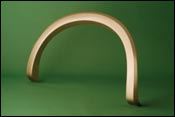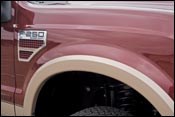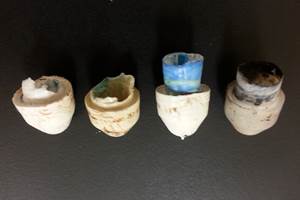Metallic-Pigmented TPO Debuts in Auto Exterior Trim
A molded-in-color, high-gloss, metallic-pigmented TPO wheel flare is making its commercial appearance next month with the launch of the 2008 F-250 Super Duty pick-up truck from the Ford Motor Co.
A molded-in-color, high-gloss, metallic-pigmented TPO wheel flare is making its commercial appearance next month with the launch of the 2008 F-250 Super Duty pick-up truck from the Ford Motor Co. This is Ford’s first vehicle with a lower-cost, more environmentally friendly alternative to painted TPO. It is believed to be an automotive industry first, because injection molding of metallic-pigmented plastics without flow lines has been a persistent challenge for automakers.
Three years in the making, this development resulted from a cooperative effort involving Ford, Solvay Engineered Polymers with its new line of high-gloss molded-in-color (MIC) TPOs, and Tier 1 supplier Plastcoat, Div. of Decoma International which contributed its innovative tool design. Ford plans to produce 80,000 of these vehicles, which translates into 320,000 MIC TPO wheel flares.
This direct replacement for a painted high-gloss, Class-A TPO part is expected to save Ford more than $3 million over the life of the program, according to LaRon Michelle Brown, research engineer with the Class-A Paintless Technology Group in the Materials and Nanotechnology Dept. of Ford’s Research and Innovation Center.
The high-gloss MIC TPO was shown to meet or exceed Ford’s requirements for surface aesthetics, durability, weatherability, and processability. Because of such advantages as lower system cost, lower VOC emissions, lower energy consumption, molding tools consolidation, and ease of recycling, the new paint alternative is being considered for wheel flares on other Ford vehicles and additional exterior applications such as door claddings and rockers.
The appearance challenge
Three years ago, Solvay launched its Indure family of scratch- and mar-resistant TPOs, which are designed for high- or low-gloss, grained or ungrained, MIC exterior or interior parts. The grade used for the wheel flares is X-76, a 35-MFR TPO that boasts superior scratch resistance, good stiffness/impact balance, and excellent processability. It replaced Solvay’s Dexflex D-160 TPO, which was painted.
Cost savings with this MIC alternative to paint—including materials, labor, and packaging/shipping—amount to $10 per vehicle, despite the fact that new TPO costs a good deal more than its predecessor. “We have no longer cycle time with MIC,” Brown explains. “Logistically, there is a savings of one day by eliminating painting, which requires prep time, cleaning, and application of adhesion promoters.”
It should be noted that the MIC TPO is being used for the accent color of the two-tone F-250 vehicles, greatly simplifying the achievement of color harmony between the painted body and MIC trim. One of the primary challenges of replacing paint has been to match the color and gloss of a Class-A system.
Mitesh Shah, a commercial development manager at Solvay Engineered Polymers, notes two factors that make it very difficult to match the color of the MIC system to that of paint at all viewing angles. One is that pigment selection for MIC is limited by the heat stability required—350 to 450 F for TPO molding vs. 180 to 250 F for a typical paint process. Second, paint achieves very thin films (60 to 80 microns) with pigment loadings of 20% to 45%, while a MIC system consists of a lower loading of pigment (<2%) dispersed in a much thicker (2 to 3 mm) medium.
According to Brown, Ford measures 60° “B” gloss levels of 86 for the MIC wheel flare, while a painted Class A surface typically has a 20° gloss of 93. There is no discernible difference in gloss when the wheel flare is placed against the painted steel fender. “Initially, this is ideal for two-toned applications, but we are working with Solvay to develop high-gloss metallic-colored TPOs for body side moldings and trims,” Brown says.
Shah adds that the surface appearance of the MIC part is the product of both the material and the tool surface quality. With the proper tool finish, Solvay’s MIC resin meets Ford’s WSS-M2P181-B Paint Performance specification QMS Target Values for Exterior Flexible Substrates in all colors from light-silver metallics to dark straight shades. For the 2008 F-250 program, the partners developed three colors—Pueblo Gold, Dark Shadow Gray, and Silver Metallic, and more colors are in development for the 2009 F-250 program.
An additional advantage for the MIC TPO is more reliably consistent part appearance out of the mold, compared with variations in a painted finish caused by “orange peel,” inadequate film thickness, and contaminants.
Durable & weatherable
New material developments such as the Indure X-76 TPO have significantly reduced the surface durability gap between paint and MIC systems. According to Brown, X-76 actually exceeds the performance of painted TPO in chip and scratch resistance, as well as weatherability.
To simulate real-life surface durability, painted and MIC parts were mounted on a Ford vehicle and subjected to 60 car washes in a commercial facility. The MIC TPO maintained more than 90% of initial gloss and was visually acceptable.
UV stability of the MIC TPO was confirmed by comparing the performance of the paint and the MIC system in an Atlas Xenon Arc Weatherometer. Testing was conducted by Solvay Engineered Polymers and Ford Central Labs according to the SAE J1960 standard. After 5500 hr, color change for the MIC TPO was very similar to that of the painted TPO, Brown reports. Long-term outdoor testing in Arizona and Florida is under way.
Processing and tooling
Innovative tooling and extensive processing development were required to produce an MIC TPO part with the same surface appearance and gloss as paint. Reducing the appearance of flow and knit lines on MIC parts was the most significant challenge, according to Shah. Knit-line appearance can vary according to the distance the material has to travel before two flow fronts come together. This is typically addressed through gate design and location and tailoring the flow characteristics of the substrate.
Plastcoat’s program manager, Dean Comeau, notes that the company’s design team worked with toolmaker Accurate Mould of Toronto to design a tool with a proprietary gate design suited to the metallic TPO. “The process window is standard, but what is different is how we fill the tool to control the flow so that the metallic flake won’t ‘roll over’ and produce inconsistent metallic effect,” Comeau notes.
Molding front and rear flares required two tools with one or two cavities each. These are basically standard tools with high polish on the cavity side. Each mold uses a hot-runner system from Synventive that is designed to facilitate color changes and reduce the need for frequent purging. The manifold system is a standard Synventive XP-T24VG-I with a custom fitting to eliminate dead ends and streamline the flow to speed color changes.
Ford and its partners claim that the MIC TPO system has advantages over other paint alternatives, such as in-mold films. In particular, the MIC system produces a finished part in one step whereas in-mold film systems involve multiple steps that provide more opportunities to generate scrap and rejects. Coinjection molding makes it possible to recycle the MIC scrap in the core of new parts, reducing net waste to essentially zero.
Related Content
How to Start a Hot-Runner Mold That Has No Tip Insulators
Here's a method to assist with efficient dark-to-light color changes on hot-runner systems that are hot-tipped.
Read MoreTosaf’s Investments in North America Result in 40% Increase in Production Capacity
Backed by a global presence, Tosaf provides localized additive and color solutions, and services for the plastic industry in North America.
Read MoreSpecialty Purging Compounds Optimize Color and Material Changeovers
Selecting of the correct purging compound can speed up material and color changeover time and reduce scrap. You’ll even save on material.
Read MoreUnderstanding the ‘Science’ of Color
And as with all sciences, there are fundamentals that must be considered to do color right. Here’s a helpful start.
Read MoreRead Next
Recycling Partners Collaborate to Eliminate Production Scrap Waste at NPE2024
A collaboration between show organizer PLASTICS, recycler CPR and size reduction experts WEIMA and Conair will seek to recover and recycle 100% of the parts produced at the show.
Read MoreBeyond Prototypes: 8 Ways the Plastics Industry Is Using 3D Printing
Plastics processors are finding applications for 3D printing around the plant and across the supply chain. Here are 8 examples to look for at NPE2024.
Read More







 (2).jpg;maxWidth=300;quality=90)





















